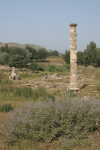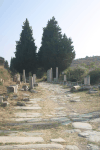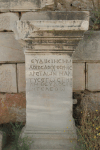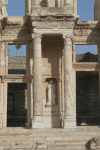
Schematic of the original Artemis temple. (653k)
Selçuk is the modern city close to the Roman Ephesus. It is also the site of the Artemis Temple, one of the classical Seven Wonders of the World. An interesting Byzantine aqueduct runs through parts of the city.
Already settled by the Hittites, the area became important around 1200 BCE, when Ionians from Greece founded Ephesus (along with Priene and Miletus). It remained an important area till Byzantine times.
Ephesus is a UNESCO World Heritage Site.
All pictures are © Dr. Günther Eichhorn, unless otherwise noted.
Anatolia originally worshiped the ancient fertility Goddess Cybele. She later turned into the Greek virgin Goddess of the Hunt and the Moon, Artemis. A fabulous temple was build in her honor. When the Romans took over, Artemis became Diana.
This site was a place of pilgrimage already in 800 BCE. Around 600 BCE, when Croesus conquered Ephesus, he paid for the construction of the Artemis temple.
In 356 BCE, the temple was destroyed in a fire. The Ephesians rebuilt the temple on a grandiose scale. After it was finished, it was recognized as one of the Seven Wonders of the World.
Now, only one column remains of this fabulous temple.
Of the Seven Wonders of the World, only one still exists completely, the Great Pyramid of Giza, which I saw during my visit to Egypt. The ruins of one of the others (Mausoleum of Maussollos at Halicarnassus) still can be seen in Turkey (I missed that one). The others (Hanging Gardens of Semiramis, Statue of Zeus at Olympia, Colossus of Rhodes, Lighthouse of Alexandria) don't exist anymore.




The 6th century Byzantine aqueduct in Selçuk is an annual nesting place for storks. Some of its pillars are used to support newer houses.



Ephesus was started by Androclus, son of King Codrus of Athens. It was a prosperous city by 600 BCE.
Ephesus prospered so much during Lydian times, that King Croesus became so envious that he attacked Ephesus and destroyed it. Ephesus was forced to pay tribute to the Lydians, as well as later to the Persians.
Roman Ephesus prospered more and became the capital of Asia Minor. Its population grew to 250,000, a huge city for that time. Many of the emperors tried to outdo each other in beautifying Ephesus.
It also attracted many Christians, among them St. John with the Virgin Mary. He supposedly wrote his gospel in Ephesus. His remains are supposed to be in Ephesus. St. Paul; also spent three years in Ephesus, probably in the CE 60's.
Eventually, the harbor silted up, and Ephesus began to decline. When Emperor Justinian (527 - 565) erected a magnificent church, the Basilica of St. John, it was in Selçuk on Ayasuluk Hill, not in Ephesus.
The magnificent Library of Celsus was built in 114 by Consul Tiberius Julius Aquila to honor his father, Celsus Ploemaeanus, Roman governor of Asia Minor early in the 2nd century CE.
The Great Theater of Ephesus was built by the Romans from 41 to 117 CE. The first theater was built during the Hellenistic period. Many features of the original building were incorporated into the Roman theater. It was capable of holding 25,000 people.




















This page contains 27 pictures

Main page for Türkiye Cumhurieti (Turkey)
Page last updated on Tue Sep 24 18:19:03 2019 (Mountain Standard Time)
Page last updated on Wed Apr 24 22:02:47 2024 (Mountain Standard Time)
Selçuk (Ephesus) on aerobaticsweb.org